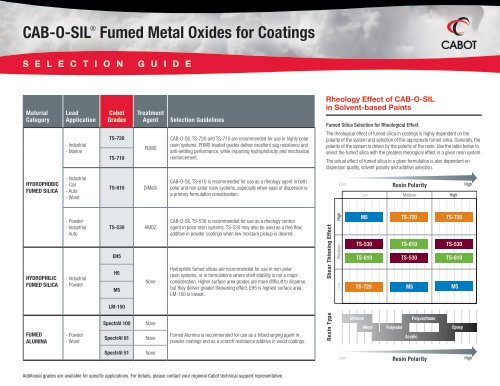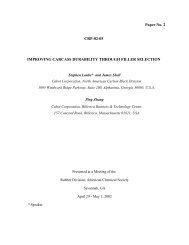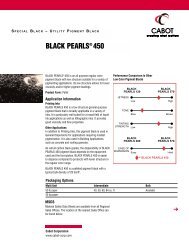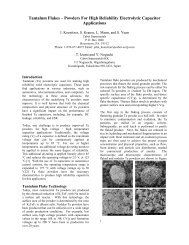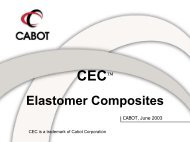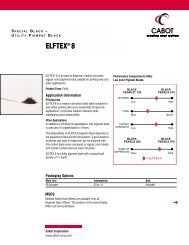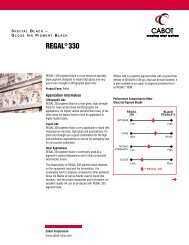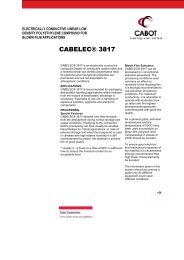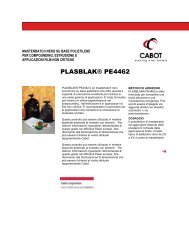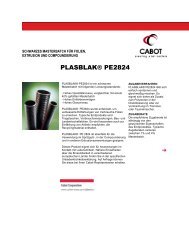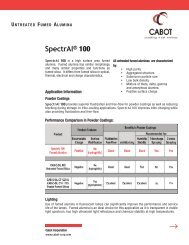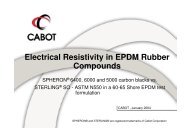CAB-O-SIL® Fumed Metal Oxides for Coatings - Cabot Corporation
CAB-O-SIL® Fumed Metal Oxides for Coatings - Cabot Corporation
CAB-O-SIL® Fumed Metal Oxides for Coatings - Cabot Corporation
Create successful ePaper yourself
Turn your PDF publications into a flip-book with our unique Google optimized e-Paper software.
<strong>CAB</strong>-O-SIL ®<br />
<strong>Fumed</strong> <strong>Metal</strong> <strong>Oxides</strong> <strong>for</strong> <strong>Coatings</strong><br />
s e l e c t i o n g u i d e<br />
Material<br />
Category<br />
HydrOpHOBIC<br />
FuMed SILICA<br />
HydrOpHILIC<br />
FuMed SILICA<br />
FuMed<br />
ALuMInA<br />
Lead<br />
Application<br />
- Industrial<br />
- Marine<br />
- Industrial<br />
- Coil<br />
- auto<br />
- Wood<br />
- Powder<br />
- Industrial<br />
- auto<br />
- Industrial<br />
- Powder<br />
- Powder<br />
- Wood<br />
<strong>Cabot</strong><br />
Grades<br />
TS-720<br />
TS-710<br />
Treatment<br />
Agent Selection Guidelines<br />
PDMS<br />
TS-610 DiMeDi<br />
TS-530 HMDZ<br />
eH5<br />
H5<br />
M5<br />
LM-150<br />
None<br />
SpectrAl 100 None<br />
SpectrAl 81 None<br />
SpectrAl 51 None<br />
Cab-O-SIl TS-720 and TS-710 are recommended <strong>for</strong> use in highly polar<br />
resin systems. PDMS treated grades deliver excellent sag resistance and<br />
anti-settling per<strong>for</strong>mance, while imparting hydrophobicity and mechanical<br />
rein<strong>for</strong>cement.<br />
Cab-O-SIl TS-610 is recommended <strong>for</strong> use as a rheology agent in both<br />
polar and non-polar resin systems, especially when ease of dispersion is<br />
a primary <strong>for</strong>mulation consideration.<br />
Cab-O-SIl TS-530 is recommended <strong>for</strong> use as a rheology control<br />
agent in polar resin systems. TS-530 may also be used as a free flow<br />
additive in powder coatings when low moisture pickup is desired.<br />
Hydrophilic fumed silicas are recommended <strong>for</strong> use in non-polar<br />
resin systems, or in <strong>for</strong>mulations where shelf stability is not a major<br />
consideration. Higher surface area grades are more difficult to disperse,<br />
but they deliver greater thickening effect. EH5 is highest surface area,<br />
lM-150 is lowest.<br />
<strong>Fumed</strong> alumina is recommended <strong>for</strong> use as a tribocharging agent in<br />
powder coatings and as a scratch resistance additive in wood coatings.<br />
Additional grades are available <strong>for</strong> specific applications. For details, please contact your regional <strong>Cabot</strong> technical support representative.<br />
Rheology effect of cAB-o-sil<br />
in solvent-based Paints<br />
<strong>Fumed</strong> Silica Selection <strong>for</strong> Rheological Effect<br />
The rheological effect of fumed silica in coatings is highly dependent on the<br />
polarity of the system and selection of the appropriate fumed silica. Generally, the<br />
polarity of the system is driven by the polarity of the resin. Use the table below to<br />
select the fumed silica with the greatest rheological effect in a given resin system.<br />
The actual effect of fumed silica in a given <strong>for</strong>mulation is also dependent on<br />
dispersion quality, solvent polarity and additive selection.<br />
Shear Thinning Effect<br />
Resin Type<br />
Medium High<br />
Low<br />
Low Resin Polarity<br />
High<br />
Low<br />
Silicone<br />
Low Medium<br />
High<br />
M5<br />
TS-720<br />
Alkyd<br />
Polyester<br />
TS-720<br />
M5 M5<br />
Acrylic<br />
Polyurethane<br />
TS-720<br />
TS-530 TS-610<br />
TS-530<br />
TS-610 TS-530<br />
TS-610<br />
Resin Polarity<br />
Epoxy<br />
High
<strong>CAB</strong>-O-SIL ®<br />
<strong>Fumed</strong> <strong>Metal</strong> <strong>Oxides</strong> <strong>for</strong> <strong>Coatings</strong><br />
PeRfoRmAnce Benefits<br />
fumed silica: Key Product Benefits<br />
<strong>Fumed</strong> Silica delivers rheology control, mechanical enhancement and anti-corrosive per<strong>for</strong>mance in a wide variety of coatings applications. Optimal per<strong>for</strong>mance is enabled by selecting the appropriate grade.<br />
All <strong>CAB</strong>-O-SIL products deliver rheology control and mechanical enhancement. Anti-corrosive per<strong>for</strong>mance is maximized with <strong>Cabot</strong>’s most hydrophilic grades, TS-720, TS-710 and TS-530.<br />
1: rheology Control<br />
Rheology control is one of the most common uses of treated and untreated<br />
fumed silica in coatings. The main functions of a rheology control agent are:<br />
Sag resistance<br />
The resistance of a coating to flow under its own rate. The higher the<br />
thickness of a coating, the greater sag resistance is required. <strong>Fumed</strong> silica<br />
particles have the ability to network and span volume much more efficiently<br />
than other particles.<br />
Epoxy Coating without <strong>CAB</strong>-O-SIL<br />
Anti-settling<br />
The ability of an additive to prevent the settling of heavy pigments present in<br />
the coating. <strong>Fumed</strong> silica prevents settling due to its ability to <strong>for</strong>m a network<br />
within the coating and hold the denser pigments in place.<br />
Coating with significant<br />
pigment settling<br />
Epoxy Coating with <strong>CAB</strong>-O-SIL<br />
Coating without any<br />
pigment settling<br />
Notice and Disclaimer: The data and conclusions contained herein are based on work believed to be reliable; however,<br />
<strong>Cabot</strong> cannot and does not guarantee that similar results and/or conclusions will be obtained by others. This in<strong>for</strong>mation<br />
is <strong>for</strong> in<strong>for</strong>mational purposes only. all product sales are subject to <strong>Cabot</strong>’s terms of sale available at cabotcorp.com.<br />
2: Mechanical enhancement<br />
<strong>Fumed</strong> Silica enhances the resistance of cured coatings to mechanical stress.<br />
The introduction of hard fumed silica particles inhibit scratching on the surface of<br />
a coating, and they improve the ability of a coating to dissipate energy without<br />
catastrophic failures in the <strong>for</strong>m of large cracks.<br />
Scratch resistance<br />
The ability of a film surface to resist cracks and micro-cracks when abraded.<br />
The hard silica particles are distributed throughout the film, including at the<br />
surface where they improve scratch resistance.<br />
Control<br />
(w/o Cab-O-SIl)<br />
<strong>CAB</strong>-O-SIL<br />
<strong>CAB</strong>-O-SIL de<strong>for</strong>mation point Increased<br />
Control de<strong>for</strong>mation point<br />
de<strong>for</strong>mation<br />
Increasing Force<br />
Test conditions: a diamond tip drawn across the surface of a coating at<br />
increasing <strong>for</strong>ce, observed under optical microscope. Scale = 2mm.<br />
Hardness<br />
The amount of <strong>for</strong>ce required to de<strong>for</strong>m the coating permanently. When <strong>for</strong>ce is<br />
applied to a coating containing Cab-O-SIl, the <strong>for</strong>ce is transferred to the<br />
harder silica particle, effectively increasing the hardness of the entire film.<br />
Hardness (Mpa)<br />
220<br />
200<br />
180<br />
.5% 1% 2% 3%<br />
<strong>CAB</strong>-O-SIL Loading<br />
Increasing the loading of<br />
Cab-O-SIl in this acrylic<br />
coating increases the<br />
hardness of the film by<br />
more than 10%.<br />
3: Anti-corrosion<br />
<strong>Fumed</strong> Silica enhances the ability of a coating to prevent corrosion. The<br />
introduction of hydrophobic fumed silica particles helps prevent the migration of<br />
water from the surface of the film to the substrate below.<br />
Anti-blistering<br />
<strong>Metal</strong> substrates corrode in the presence of water, oxygen and an electrolyte.<br />
This reaction results in the delamination of the coating from the substrate.<br />
<strong>Fumed</strong> silica prevents water from reaching the substrate, thereby minimizing<br />
blistering.<br />
Epoxy system<br />
Without <strong>CAB</strong>-O-SIL <strong>Fumed</strong> Silica<br />
reduced Scribe Creep<br />
With <strong>CAB</strong>-O-SIL <strong>Fumed</strong> Silica<br />
a coatings ability to prevent corrosion is severely compromised by the<br />
presence of deep scratches. <strong>Fumed</strong> silica minimizes this effect by preventing<br />
water from penetrating the film at the point of the scratch, inhibiting corrosion<br />
and further delamination.<br />
Alkyd system<br />
Control Without <strong>Fumed</strong> SilicaTS-720 With <strong>Fumed</strong> Silica<br />
cabotcorp.com<br />
Technical Support – North America: 1 800 462 2313; South America: +55 11 2144 6400; Europe: +31 71 888 4132; Asia Pacific: +86 21 5175 8800<br />
<strong>CAB</strong>-O-SIL and SpectrAl are registered trademarks of <strong>Cabot</strong> <strong>Corporation</strong>. Aerosil is a registered trademark of Evonik. © 2012 <strong>Cabot</strong> <strong>Corporation</strong>. all rights reserved worldwide. R01 6/12


